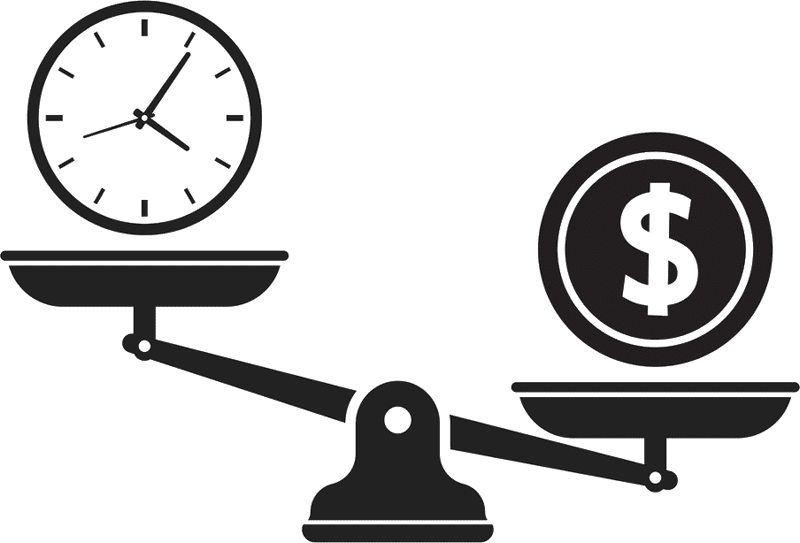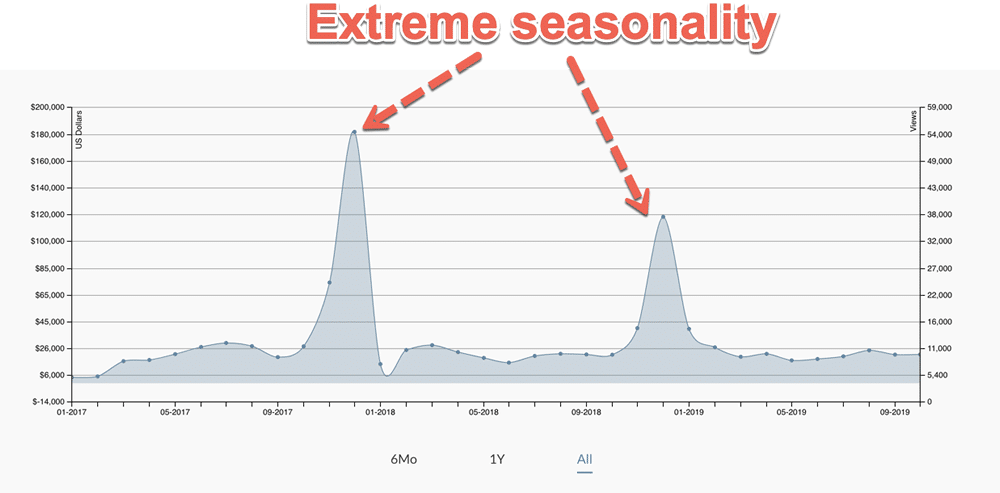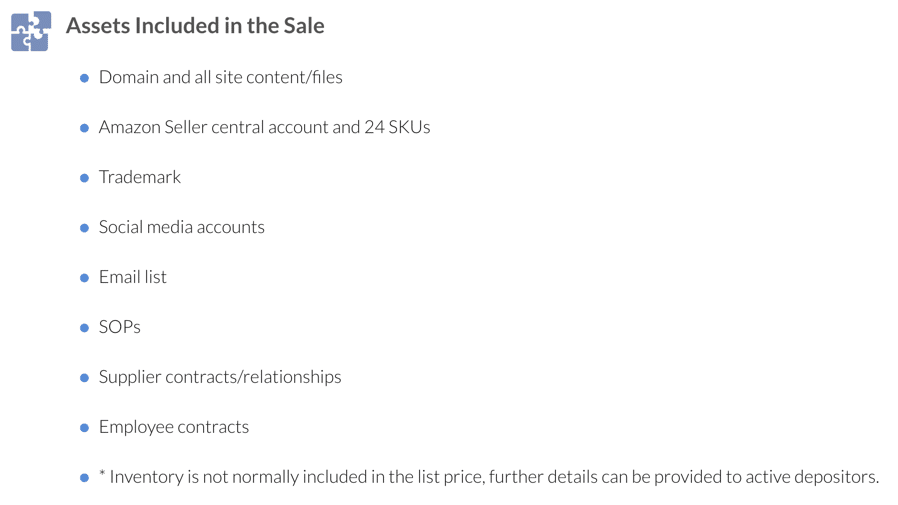This post is by Nate McCallister, founder of EntreResource.com and FBA Today.
Despite what you may have heard, there’s nothing passive about growing an Amazon business.
If a seller makes $10,000 on Black Friday, they earned the money in the weeks, months or even years prior to that. As with most good things, getting started and building momentum is the hardest part.
This is why many entrepreneurs are buying established Amazon businesses instead of starting their own from scratch. They understand the value of the groundwork that someone else has already laid down for them.
If you’re interested in buying your way into an established Amazon business, please read every word of this article first. This is a huge decision and you owe it to yourself to be as informed as possible.
Reasons to buy an existing Amazon storefront
While the ultimate reason is to achieve a huge ROI, there are three big reasons why buying an existing Amazon business is a more viable option for many entrepreneurs than starting from scratch.
Reason #1: You have more money than time

Amazon storefronts aren’t cheap. They can cost anywhere from 18x-36x monthly profits. If a storefront is making $10k per month in profit, it might sell for around $180,000 to $360,000. That usually doesn’t even include the cost of the inventory.
You can open a professional Amazon selling account for $40 per month, but the time, money and energy required to carve out a profitable storefront is tremendous. Capital is usually the biggest reason Amazon sellers don’t scale or scale very slowly.
A successful business that’s limited by capital can see tremendous gains quickly if it’s taken over by someone who has capital to spend. Savvy investors with deep pockets know this and they can often turn moderately successful Amazon businesses into massively successful ones thanks to a new influx of capital.
They can use their capital to leverage economies of scale. They can negotiate better rates with suppliers, ramp up ad spend and invest in things that their competitors might not be able to.
Reason #2: You want to reduce the risk of failure to launch
There is no way to avoid risk, but you can choose which ones you take.
Cherry-picking an already successful Amazon storefront means you can focus on optimizing and scaling rather than dabbling in many different products until one sticks.
Here are the difficulties that often crash Amazon businesses that you can avoid almost entirely:
- Finding a great product from a reputable source
- Negotiating with your supplier so you have the best margins possible
- Building relationships
- Creating unique marketing advantages
- Creating refined SOPs from trial and error
- Building a customer base that will buy from you again and again
- Getting reviews and building credibility
Anyone who has done all of the above themselves, knows how lucky they are if they have the money to bypass them.
Reason #3: You have a unique pre-existing advantage
Many Amazon businesses are purchased by people who have a unique competitive advantage that makes the opportunity much more valuable to them than to others.
For instance, a fitness influencer with a large email list and Instagram following could purchase a storefront that sells a popular wrist wrap product. They can take that product and sell it immediately to their existing audience and see results very quickly.
Another example of a competitive advantage would be someone who is uniquely skilled with Amazon product optimization. They know Amazon well and can spot areas for improvement in an existing product or storefront, implement the changes, and reap the benefits.
This is similar to someone who invests in real estate. They can spot properties with potential for big increases in value after certain improvements have been made.
Factors to consider before buying an Amazon business
Here are the big factors to consider when shopping for an Amazon storefront.
1. Where their products come from
There are three main types of Amazon businesses:
- Private label (their own unique branded products)
- Buying direct from suppliers or wholesalers
- Arbitrage (retail arbitrage and online arbitrage)
Private label businesses are typically the most valuable while arbitrage businesses are the least valuable since they require a lot of ongoing effort and lack a real, unique competitive advantage.
2. Business age and sales history
A good storefront will have consistent growth over several years. When browsing for a storefront, you’ll see a lot of fairly new accounts with sudden bursts of sales. Resist the siren’s call of these. You should look for something established and proven.
Another thing to be aware of is extreme seasonality of product sales.

There are several risk factors involved here.
Risk of the product being replaced with new technology or better products. Does the product have a unique competitive advantage? Is it just a trend that will fade away? Will other sellers find the product with a tool like Jungle Scout or Helium 10 and take over the top keywords?
Risk of the product being removed from Amazon or the seller account being suspended. Account and product-specific suspensions are far from uncommon on Amazon. Always ask the seller about account health and history of performance issues.
Tip: If you suspect a storefront was suspended in the past, you can check the sales history and look for periods with no sales data.
Pay attention to account health and seller reviews. You don’t want to have to clean up someone else’s poor performance metrics.
Risk of financial liability if a customer is harmed. You don’t want to be held responsible for someone else’s mistakes. Business insurance is a must, of course.
3. Product review quantity and quality
This applies mostly to private label storefronts. Product reviews are much less important on storefronts with broad selections of third-party products. Looking at product reviews will give you a good insight about their customer service practices.
Use a free Amazon review analyzer like Fake Spot to ensure that the reviews are legitimate.
4. Existence of SOPs
Businesses that have high quality documentation of their processes are much easier to take over. A good business should have great SOPs (standard operating procedures).
5. Costs
You need to know every single expense related to the business. These include but aren’t limited to:
- Ad spend (on and off Amazon)
- Software
- Storage fees
- Inventory
- Promotional expenses
- Payroll (if applicable)
- Freight (if applicable)
Overlooking costs can be disastrous.
6. Transition support
A good purchase requires a smooth transition from seller to buyer. This means that you and the seller need to clearly communicate what is expected before you buy.
- How long will they help?
- What tasks will they help with?
- How will you communicate? In person, Skype etc.
Expensive storefronts should come with several weeks of transition support.
7. Reason for selling
It’s very reasonable to ask the seller why they are leaving the business. There are many valid reasons for someone to sell their Amazon business.
They may have other opportunities and value the upfront capital over the long term value of the storefront. They might just be burnt out from the process (it’s not for everyone).
Whatever the reasoning, you need to find it out before you buy. The last thing you want is to take on a business that has some kind of fatal issue that the seller is running away from.
8. Inventory
What is the resale value of the physical inventory included? Some storefronts have little to no inventory on hand while others have thousands of units in warehouses.
Are you paying what the seller paid or are you paying full retail price? Be sure to ask.
This number should be added to the profit multiplier when calculating storefront value. For instance, a storefront making $10k per month with $60,000 in inventory that sells at a 24x multiplier would be worth $300,000 (24 x $10,000 + $60,000).
Note: Some third-party brokers don’t include the inventory in the purchase price. Be sure to verify if the storefront you are buying comes with the inventory or if that is an additional expense.
9. Order fulfillment
Most buyers will want a business that is leveraging the FBA (Fulfillment by Amazon) program, but some storefronts do a lot of merchant fulfilling. Find out what is needed to fulfill orders.
10. Intangible assets
The following intangible assets add value to a storefront:
- Trademarks
- Branded domain and website
- Social media accounts and followers
- Mailing lists
Empire Flippers does a great job of sharing this on their listings:

11. Diversification
Diversification is an important factor when assessing risk.
This can refer to how many unique products are being sold and also if the products are sold anywhere beyond Amazon.
Companies that sell their products on other platforms, like Shopify, in addition to Amazon are typically worth more than those that only sell on Amazon. They have less risk. If you diversify off Amazon, your brand won’t be destroyed if you have a temporary or permanent account suspension.
How much should you pay for an Amazon business?
This all depends on the factors we just mentioned.
Going through a reputable broker (which we’ll touch on next) will help ensure that you’re paying a fair price, but the price ranges anywhere from 18x-36x monthly profits, plus the inventory value.
Where to find an Amazon business to buy
I highly recommend that you go through a professional broker rather than attempt to negotiate a deal without one.
A broker is a third-party that will facilitate the sale and transition of the storefront from seller to buyer. They aren’t cheap, but a good broker will ensure all the i’s are dotted and the t’s are crossed. They’ll be able to hold the funds in escrow to ensure that no funny business happens during payment and transition of the store.
There are a number of brokers, but the gold standard in my opinion is Empire Flippers. They go to extreme lengths to ensure only great storefronts are sold on their platform. They work hard for their sellers and buyers, providing detailed listings that answer every question you have before making a purchase.
Other options are Flippa, Digital Exits and FE International.
A good broker will take care of everything and make sure you know what’s happening with the purchase each step of the way.
Final word
Buying an existing Amazon business can be a tremendous investment if you do your due diligence and understand what to look for.
But it isn’t for everyone and shouldn’t be taken lightly. It takes research, capital and negotiation skills to pull off, and a lot of patience to fully recoup your initial investment.
Nate McCallister started selling on Amazon in 2014 and founded the popular Facebook group for Amazon sellers, FBA Today. He blogs about internet business with an emphasis on online arbitrage, productivity and digital marketing.

Leave a Reply